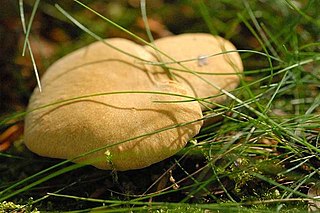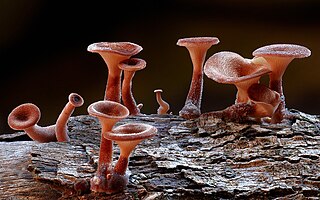
A hypha is a long, branching, filamentous structure of a fungus, oomycete, or actinobacterium. In most fungi, hyphae are the main mode of vegetative growth, and are collectively called a mycelium.

The Polyporales are an order of about 1800 species of fungi in the division Basidiomycota. The order includes some polypores as well as many corticioid fungi and a few agarics. Many species within the order are saprotrophic, most of them wood-rotters. Some genera, such as Ganoderma and Fomes, contain species that attack living tissues and then continue to degrade the wood of their dead hosts. Those of economic importance include several important pathogens of trees and a few species that cause damage by rotting structural timber. Some of the Polyporales are commercially cultivated and marketed for use as food items or in traditional Chinese medicine.

The fungal order Agaricales, also known as gilled mushrooms or euagarics, contains some of the most familiar types of mushrooms. The order has 33 extant families, 413 genera, and over 13,000 described species, along with six extinct genera known only from the fossil record. They range from the ubiquitous common mushroom to the deadly destroying angel and the hallucinogenic fly agaric to the bioluminescent jack-o-lantern mushroom.

Cerioporus squamosus aka Polyporus squamosus is a basidiomycete bracket fungus, with common names including dryad's saddle and pheasant's back mushroom. It has a widespread distribution, being found in North America, Australia, Asia, and Europe, where it causes a white rot in the heartwood of living and dead hardwood trees. The name "dryad's saddle" refers to creatures in Greek mythology called dryads who could conceivably fit and ride on this mushroom, whereas the pheasant's back analogy derives from the pattern of colors on the bracket matching that of a pheasant's back.

Neolentinus is a genus of wood-decaying agarics with tough fruit bodies composed of dimitic tissue, serrated lamella edges, and nonamyloid white binucleate basidiospores among other features. It was segregated from Lentinus in the broad taxonomic sense, hence the derivation of the name. Biologically Neolentinus species produce a brown rot type of decay of wood, whereas Lentinus causes a white rot. Molecular phylogenetic analysis shows that the two genera are unrelated. Neolentinus is phylogenetically allied to other brown rot genera such as Gloeophyllum, Heliocybe, and Veluticeps. A new order, the Gloeophyllales, has been described for these fungi. Heliocybe had been placed in synonymy but it differs phylogenetically and anatomically by the lack of clamp connections that all Neolentinus produce on their generative hyphae.

Polyporus is a genus of poroid fungi in the family Polyporaceae.

Lentinus tigrinus is a mushroom in the Polyporaceae family. It is classified as nonpoisonous. It has been reported that mushrooms have significant antioxidant and antimicrobial activity.

Lentinus is a genus of fungi in the family Polyporaceae. The genus is widely distributed, with many species found in subtropical regions.

Favolus, or honeycomb fungus, is a genus of fungi in the family Polyporaceae. The fruit bodies of Favolus species are fleshy with radially arranged pores on the underside of the cap that are angular and deeply pitted, somewhat resembling a honeycomb.

Cerioporus leptocephalus, commonly known as blackfoot polypore, is an inedible species of mushroom in the genus Cerioporus. It usually grows on the branches of broad leaved trees. Formerly placed in the genus Polyporus, this species was moved into Cerioporus in 2016.

Auriscalpium vulgare, commonly known as the pinecone mushroom, the cone tooth, or the ear-pick fungus, is a species of fungus in the family Auriscalpiaceae of the order Russulales. It was first described in 1753 by Carl Linnaeus, who included it as a member of the tooth fungi genus Hydnum, but British mycologist Samuel Frederick Gray recognized its uniqueness and in 1821 transferred it to the genus Auriscalpium that he created to contain it. The fungus is widely distributed in Europe, Central America, North America, and temperate Asia. Although common, its small size and nondescript colors lead it to be easily overlooked in the pine woods where it grows. A. vulgare is not generally considered edible because of its tough texture, but some historical literature says it used to be consumed in France and Italy.
Cyanotrama is a fungal genus in the Hymenochaetales order. The genus is monotypic, containing the single species Cyanotrama rimosa, widely distributed in western North America. It has also been collected in single occasions in Ethiopia and Iran. The fungus causes a white rot in conifers, especially junipers. C. rimosa was originally named Poria rimos in 1920 by William Alphonso Murrill, and later known as Diplomitoporus rimosus. Molecular work revealed that the species was aligned not with the polyporoid fungi as previously assumed, but rather with the hymenochaetoid fungi, and Cyanotrama was created to contain it. The genus name refers to the strong cyanophilic reaction of the skeletal hyphae, particularly noticeable in the trama.

Royoporus badius or Picipes badius, commonly known as the black-footed polypore or black-leg, is a species of fungus in the family Polyporaceae. It causes a white rot of hardwoods and conifers. The species is found in temperate areas of Asia, Australia, Europe, and North America. It has a dark brown or reddish-brown cap that reaches a diameter of 25 cm (9.8 in), and a stipe that is often completely black or brown at the top and black at the base.
Lentinus roseus is a species of edible mushroom in the family Polyporaceae, first found in northern Thailand.
Lentinus concentricus is a species of edible mushroom in the family Polyporaceae, first found in northern Thailand and described as new to science in 2011.
Lentinus megacystidiatus is a species of edible mushroom in the family Polyporaceae, first found in northern Thailand.

Polyporus meridionalis is a species of fungus. First described in 1973 as a species of the now-defunct genus Leucoporus, it was transferred to Polyporus in 1980. In 2016, Zmitrovich and Kovalenko proposed a transfer to Cerioporus.
Leifiporia is a genus of two species of poroid white rot crust fungi in the family Polyporaceae. The genus was circumscribed by Chinese mycologists in 2016 to accommodate the type species Leifiporia rhizomorpha.
Butyrea is a genus of two species of crust fungi in the family Steccherinaceae.

Panus fasciatus is a species of fungi in the family Polyporaceae in the genus Panus of the Basidiomycota. P. fasciatus has a fruiting body in the shape of a funnel with a velvety texture, hence the nickname "hairy trumpet." When it was identified by D. Pegler of Kew, he created a subgroup of the Lentinus fungi, called Panus based on their hyphal systems. For this reason, Panus fasciatus is sometimes referred to as Lentinus fasciatus. Panus fasciatus has been described with numerous other names which were combined by Pegler in 1965.















